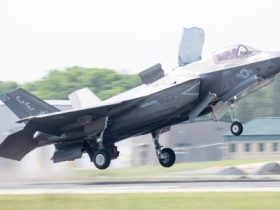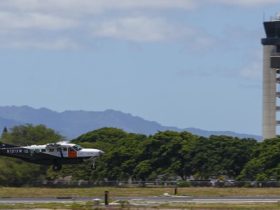The Missile Defense Agency’s budget request for fiscal 2026 is flat at $10.2 billion and depends on another $3 billion in supplemental funding not yet passed by Congress, bringing the total ask to $13.2 billion, according to Defense Department documents.
If both the budget and supplement were approved by Congress, the agency would receive a boost in funding from last year.
“This budget represents a $2.8 billion increase (27%) over our FY 2025 enacted President’s Budget,” an MDA budget overview document states.
Of that total, MDA is requesting $10.5 billion in research, development, test and evaluation funding, $1.6 billion in procurement, $720.4 million in operations and maintenance and $306.4 million for military construction.
The agency asked for just $10.4 billion in fiscal 2025, $500 million less than the amount leaders had said the agency needed in the prior fiscal year. Without the supplemental funding, the FY26 base budget marks another small reduction.
While MDA’s budget is relatively flat, the Pentagon is planning to invest big in President Donald Trump’s “Golden Dome” for homeland defense.
The DOD is asking for $25 billion to buy more missile defense interceptors, such as Patriot air and missile defense missiles, “novel intercept capabilities including space-based systems” and a “down payment” on advanced sensors and command-and-control systems that will fit into the overall architecture, a defense official told reporters at the Pentagon last week.
The entirety of that $25 billion for Golden Dome is included in the Pentagon’s supplemental funding request that it is banking on Congress passing as part of a $113 billion party-line spending bill now under debate.
It is unclear from publicly available documents if the $3 billion in supplemental funding that would be part of MDA’s budget is separate or part of the $25 billion Golden Dome request.
The agency plans to focus $3.2 billion in funding in fiscal 2026 for the Ground Based Midcourse Defense system, designed to defend the homeland against intercontinental ballistic missiles from Iran and North Korea.
The funding would also support continued development of the Next-Generation Interceptor that would replace the current Ground-Based Interceptors.
MDA is delayed roughly 18 months in fielding its NGI. The agency chose a winner over a year earlier than planned, selecting Lockheed Martin and its partner L3Harris’ Aerojet Rocketdyne in April 2024 to continue the development of NGI.
The request for fiscal 2026 includes funding for a second motor supplier for the NGI, according to budget documents.
The NGI will play a big role in the Trump administration’s Golden Dome missile defense shield, which will likely call for an increase of NGIs well beyond the 44 GBIs already in place.
Funding in fiscal 2026 would include planning for a third interceptor site to expand the GMD system likely to the East Coast. The interceptors in place are located in Alaska and California.
RELATED
Another $1 billion would go toward investing in prototypes and demonstrations of a command-and-control data mesh “designed to streamline multi-domain, multi-service data integration into a single integrated battle management system,” the agency’s budget documents state.
Included in that pot of money would be upgrades to the Joint Tactical Integrated Fires Control, which is critical to the development of a battle management capability to support operations in the defense of Guam architecture. The funding would also support the installation of the Defense of Guam’s command center network communications.
The agency is part of a wider effort to establish a robust air-and-missile defense architecture on Guam to defend the crucial island against growing threats from China as well as rogue states like North Korea. The architecture is just in the beginning stages of development and installation.
A second Discriminating Space Sensor is also included in the funding as well as integration work for new space sensing platforms and ground radars to enhance detection and coordination capabilities.
And it would continue supporting the testing of the Hypersonic and Ballistic Tracking Space Sensor prototypes that are currently orbiting the earth.
The agency is asking for $2.4 billion to enhance various aspects of the Aegis missile defense program, including beginning development of the Guam defense architecture underlayer. This includes a Network Enabled Interceptor capability for the SM-3 Block IIA and the Expeditionary Launcher.
The agency would also accelerate the development of the Glide Phase Interceptor — designed to counter hypersonic weapons — by two years, as well as modify existing the Aegis Weapon Systems to counter hypersonic threats in the glide phase of flight.
The Missile Defense Agency is facing a roughly three-year delay in its plan to deliver the GPI, according to its director.
In an attempt to mitigate the delay, the agency truncated a competitive development effort years’ early, choosing one team to go it alone to design and build GPI. But the program’s reduced funding levels have still slowed down the program, MDA confirmed in a May 6 statement to Defense News.
RELATED

In the fiscal 2024 National Defense Authorization Act, Congress mandated MDA move more quickly by requiring the agency to reach full operational capability by the end of 2032 and provide no fewer than 12 GPIs for tests by the end of 2029.
The funding the agency has received so far for the program “will actually push that delivery to 2035,” Collins said this spring.
The agency plans to buy 12 Aegis SM-3 Block IIA missiles along with other equipment, software and installation materials, the document states.
MDA would also spend an undisclosed total amount on theater-based defense to include $500 million for cooperative development efforts with Israel to include David’s Sling, the Arrow Weapon System and Iron Dome, through a memorandum of understanding established in fiscal 2019 that ends in fiscal 2028.
The agency will continue to upgrade the Terminal High Altitude Area Defense System, including the integration of THAAD with the Army’s Integrated Battle Command System, or IBCS, architecture.
The funding would also procure 37 THAAD interceptors and pay for continued THAAD sustainment to fielded batteries.
Jen Judson is an award-winning journalist covering land warfare for Defense News. She has also worked for Politico and Inside Defense. She holds a Master of Science degree in journalism from Boston University and a Bachelor of Arts degree from Kenyon College.
Read the full article here








Leave a Reply